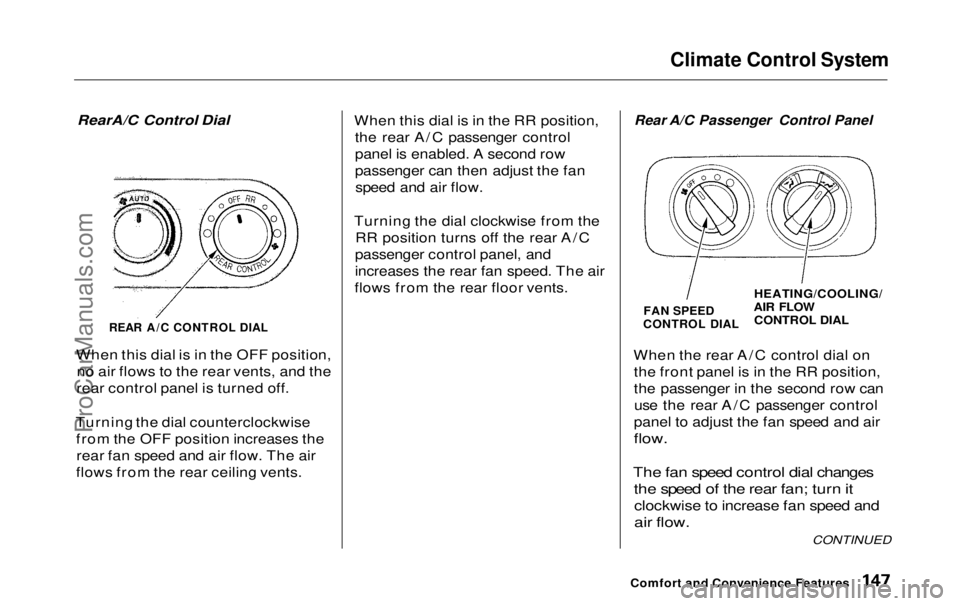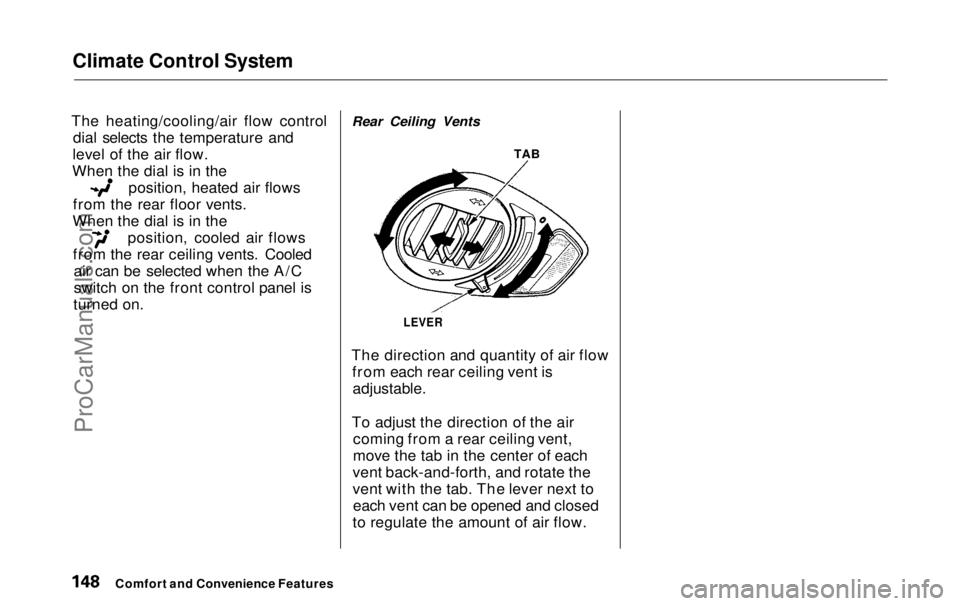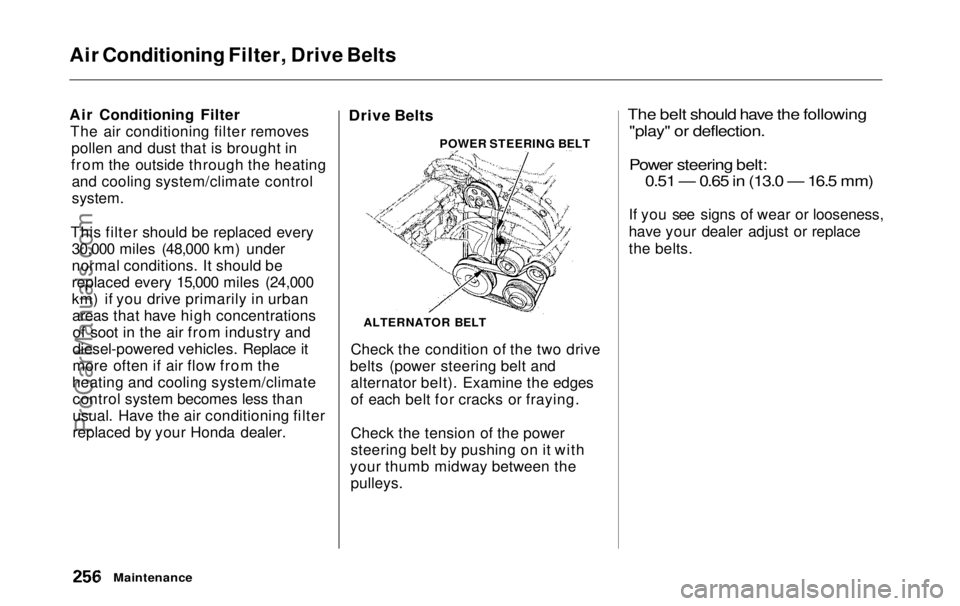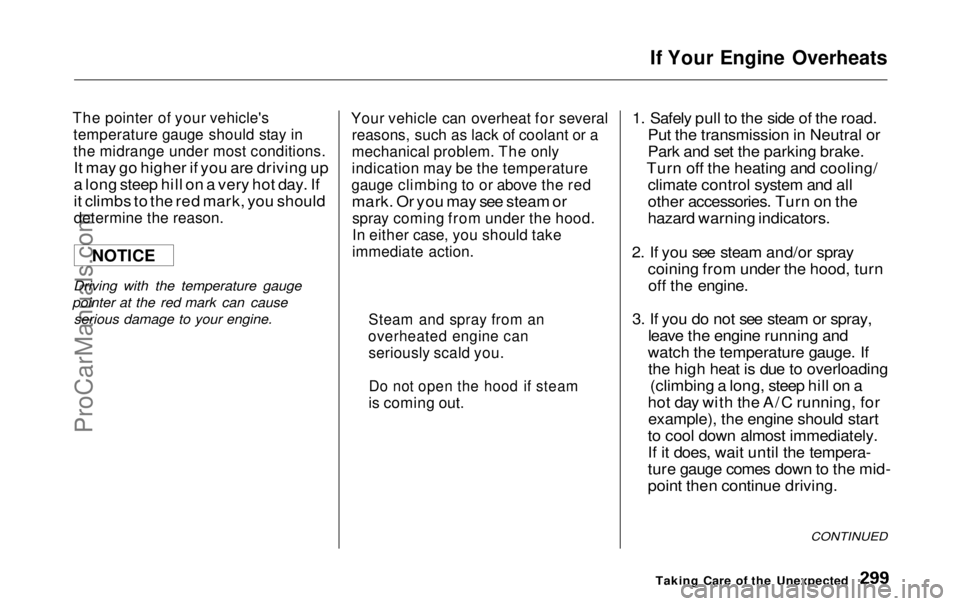1999 HONDA ODYSSEY heating
[x] Cancel search: heatingPage 148 of 343

Climate Control System
RearA/C Control Dial
REAR A/C CONTROL DIAL
When this dial is in the OFF position, no air flows to the rear vents, and the
rear control panel is turned off.
Turning the dial counterclockwise from the OFF position increases therear fan speed and air flow. The air
flows from the rear ceiling vents. When this dial is in the RR position,
the rear A/C passenger control
panel is enabled. A second row
passenger can then adjust the fanspeed and air flow.
Turning the dial clockwise from the RR position turns off the rear A/C
passenger control panel, and
increases the rear fan speed. The air
flows from the rear floor vents.
Rear A/C Passenger Control Panel
FAN SPEED
CONTROL DIAL
HEATING/COOLING/
AIR FLOW
CONTROL DIAL
When the rear A/C control dial on the front panel is in the RR position,
the passenger in the second row canuse the rear A/C passenger control
panel to adjust the fan speed and air
flow.
The fan speed control dial changes the speed of the rear fan; turn it
clockwise to increase fan speed and
air flow.
Comfort and Convenience Features
CONTINUEDProCarManuals.comMain Menu Table of Contents s t
Page 149 of 343

Climate Control System
The heating/cooling/air flow control dial selects the temperature and
level of the air flow.
When the dial is in the position, heated air flows
from the rear floor vents.
When the dial is in the position, cooled air flows
from the rear ceiling vents. Cooled air can be selected when the A/C
switch on the front control panel is
turned on. Rear Ceiling Vents
TAB
LEVER
The direction and quantity of air flow from each rear ceiling vent is
adjustable.
To adjust the direction of the air coming from a rear ceiling vent,
move the tab in the center of each
vent back-and-forth, and rotate the
vent with the tab. The lever next to each vent can be opened and closed
to regulate the amount of air flow.
Comfort and Convenience FeaturesProCarManuals.comMain Menu Table of Contents s t
Page 215 of 343

Towing a Trailer
Towing Equipment and
Accessories
Towing can require a variety of equipment, depending on the size of
your trailer, how it will be used, and how much load you are towing.
Discuss your needs with your trailersales or rental agency, and follow the
guidelines in the rest of this section.
Also make sure that all equipment is properly installed and that it meets
federal, state, province, and local
regulations.
Hitches
Any hitch used on your vehicle must
be properly bolted to the underbody, using the six threaded holes
provided. A hitch designed especially
for your Odyssey can be obtained
from your Honda dealer.
Weight Distributing Hitch
If the total trailer weight is more
than 2,000 Ibs (900 kg), you must also use a weight distributing hitch.
This device transfers weight from the vehicle's rear wheels to the front
wheels, and to the trailer's wheels. Carefully follow the hitch maker's
instructions for proper installation
and adjustment.
Safety Chain
Always use a safety chain. Make sure that it is secured to both the
trailer and hitch, and that it crosses under the tongue so it can catch the
trailer if it becomes unhitched.
Leave enough slack to allow the
trailer to turn corners easily, but do not let the chain drag on the ground. Sway Control
If the total trailer weight exceeds 2,000 Ibs (900 kg), you should install
a sway control device to minimize
swaying that can occur in crosswinds
and in normal and emergency
driving maneuvers. Your trailer
maker can tell you what kind of sway
control you need and how to install it.
Transmission Fluid Cooler
If the total trailer weight is more
than 2,000 Ibs (900 kg), you must
also have a transmission fluid cooler
installed. This device will help
prevent transmission overheating,
which could cause serious damage.
A transmission fluid cooler designed for your Odyssey can be obtainedfrom your Honda dealer.
DrivingProCarManuals.comMain Menu Table of Contents s t
Page 257 of 343

Air Conditioning Filter, Drive Belts
Air Conditioning Filter
The air conditioning filter removes pollen and dust that is brought in
from the outside through the heating and cooling system/climate control
system.
This filter should be replaced every 30,000 miles (48,000 km) under
normal conditions. It should be
replaced every 15,000 miles (24,000
km) if you drive primarily in urbanareas that have high concentrationsof soot in the air from industry and
diesel-powered vehicles. Replace it
more often if air flow from the
heating and cooling system/climate control system becomes less than
usual. Have the air conditioning filter
replaced by your Honda dealer.
Drive Belts
POWER STEERING BELT
Check the condition of the two drive
belts (power steering belt and alternator belt). Examine the edges
of each belt for cracks or fraying.
Check the tension of the power
steering belt by pushing on it with
your thumb midway between the pulleys.
The belt should have the following
"play" or deflection.
Power steering belt: 0.51 — 0.65 in (13.0 — 16.5 mm)
If you see signs of wear or looseness,
have your dealer adjust or replace
the belts.
Maintenance
ALTERNATOR BELTProCarManuals.comMain Menu Table of Contents s t
Page 298 of 343

If Your Engine Overheats
The pointer of your vehicle's
temperature gauge should stay in
the midrange under most conditions.
It may go higher if you are driving up
a long steep hill on a very hot day. If
it climbs to the red mark, you should
determine the reason.
Driving with the temperature gauge
pointer at the red mark can cause serious damage to your engine.
Your vehicle can overheat for several
reasons, such as lack of coolant or a
mechanical problem. The only
indication may be the temperature
gauge climbing to or above the red
mark. Or you may see steam or
spray coming from under the hood.
In either case, you should take
immediate action.
1. Safely pull to the side of the road.
Put the transmission in Neutral or
Park and set the parking brake.
Turn off the heating and cooling/ climate control system and all
other accessories. Turn on the
hazard warning indicators.
2. If you see steam and/or spray coining from under the hood, turnoff the engine.
3. If you do not see steam or spray, leave the engine running and
watch the temperature gauge. If the high heat is due to overloading (climbing a long, steep hill on a
hot day with the A/C running, for example), the engine should start
to cool down almost immediately.
If it does, wait until the tempera-
ture gauge comes down to the mid-
point then continue driving.
CONTINUED
Taking Care of the Unexpected
NOTICE
Steam and spray from an
overheated engine can
seriously scald you.
Do not open the hood if steam
is coming out.ProCarManuals.comMain Menu Table of Contents s t
Page 336 of 343

Index
Emergencies on the Road Brake System Indicator............ 304
Changing a Flat Tire................. 287
Charging System Indicator...... 302
Checking the Fuses................... 305
Low Oil Pressure Indicator...... 301
Malfunction Indicator Lamp.... 303 Overheated Engine................... 299
Emergency Brake.......................... 116
Emergency Flashers....................... 70
Emergency Towing....................... 311
Emissions Controls........................ 323
Engine
Coolant Temperature Gauge ..... 63
Drive Belts.................................. 256
Malfunction Indicator
Lamp............................... 58, 303
Oil Pressure Indicator........58, 301
Oil, What Kind to Use...............
233
Overheating................................
299
Specifications.............................
317
Ethanol i n
Gasoline .......................
321
Evaporative Emission
s
Controls..
323
Exhaust Fumes...............................
.
53
Exhaust Gas Recirculation System......................................... 324 Expectant Mothers, Use of Seat
Belts by......................................... 20
Exterior, Cleaning the................... 278
Fabric, Cleaning............................. 280
Fan, Interior...........................130, 142 Features, Comfort and Convenience............................... 129
Filling the Fuel Tank..................... 183
Filters
Air................................................246
Air Conditioning........................ 256
Oil................................................ 235
First Gear Position......................... 201
Flashers, Hazard Warning.............. 70
Flat Tire, Changing a.................... 287
Fluids
Automatic Transmission...........
243
Brake...........................................244
Powe r
Steering........................... 245
Windshield Washer................... 242
FM Stereo Radio Reception............................150, 162
Folding the Third Seat..................110
Foreign Countries, Driving in...... 322
Four-way Flashers........................... 70
Front End, Towing by Emergency
Wrecker...................................... 311
Fuel..................................................182
Fill Door and Cap....................... 183
Gauge............................................ 63
Octane Requirement................. 182
Oxygenated................................ 321
Reserve Indicator......................... 61
Tank, Filling the......................... 183
Fuses, Checking the...................... 306
Gas Mileage, Improving................ 188
Gasohol........................................... 321
Gasoline.......................................... 182
Fuel Reserve Indicator................ 61
Gauge............................................ 63
Octane Requirement................. 182
Tank, Filling the......................... 183
Gas Station Procedures................. 183
Gauges
Engine Coolant Temperature .... 63
Fuel................................................63ProCarManuals.comMain Menu s t
Page 337 of 343

Index
GAWR (Gross Axle Weight
Rating)........................................ 213
GCWR (Gross Combined Weight
Rating)........................................ 213
Gearshift Lever Positions............. 199
Glass Cleaning............................... 281
Glove Box......................................... 87
GVWR (Gross Vehicle Weight
Rating) ........................................ 213
Halogen Headlight Bulbs.............. 266
Hazard Warning Flashers............... 70
Headlights......................................... 66 Aiming......................................... 266
Automatic Lighting Off............... 67
Daytime Running Lights............. 67
High Beam Indicator................... 61
High Beams, Turning on............ 66
Low Beams, Turning on............. 66
Reminder Chime.......................... 66
Replacing Halogen Bulbs ......... 266
Turning on.................................... 66
Head Restraints............................. 104
Heated Mirror................................ 116 Heating and Cooling...................... 130
High Altitude, Starting at.............. 197
High-Low Beam Switch .................. 66
HomeLink Universal
Transmitter.................................. 95
Hood Latch..................................... 248
Hood, Opening the ........................ 184
Horn................................................... 65
Hot Coolant, Warning about........ 237
Hydroplaning.................................. 211
Identification Number, Vehicle.... 314
If Your Vehicle Has to be
Towed......................................... 311
Ignition
Keys...............................................76
Switch............................................78
Timing Control System............. 324
Immobilizer System......................... 77
Important Safety Precautions .......... 6
Indicator Lights, Instrument
Panel.............................................. 57
Individual Map Lights................... 127
Infant Restraint................................ 30
Inflation, Proper Tire .................... 257
Inside Mirror.................................. 115
Inspection,Tire.............................. 259
Instrument Panel........................ 2, 56
Instrument Panel Brightness......... 67
Interior Cleaning............................ 280
Interior Lights................................ 125
Introduction......................................... i
Jacking up the Vehicle.................. 290
Jack, Tire........................................ 288
Jump Starting................................. 297
Keys...................................................76
Label, Certification........................ 314
Lane Change, Signaling.................. 68
Lap/Shoulder Belts.................. 15, 45
CONTINUEDProCarManuals.comMain Menu s t
Page 338 of 343

Index
Leaking of Exhaust into Vehicle ... 53
Light Control Switch..................... 125
Lights
Bulb Replacement..................... 266
Indicator........................................ 57
Interior........................................ 125
Parking.......................................... 66
Turn Signal................................... 68
Load Limits............................. 192, 212
LOCK (Ignition Key Position)....... 78
Locks Anti-theft Steering Column........ 78
Fuel Fill Door............................. 183Glove Box..................................... 87
Lockout Prevention..................... 80
Power Door.................................. 79
Sliding Doors................................ 88
Tailgate......................................... 85
Low Coolant Level......................... 187
Low Fuel Indicator.......................... 61
Low Oil Pressure Indicator.... 58, 301
Lubricant Specifications Chart.... 316
Luggage.......................................... 191 Maintenance................................... 219
Owner Maintenance Checks.... 231
Record.................................. 229-230
Required Indicator....................... 64
Safety........................................... 220
Schedule.............................. 224-228
Malfunction Indicator Lamp.. 58, 303
Manual Sliding Doors...................... 88
Maximum Allowable Speeds........ 201
Meters, Gauges................................ 62
Methanol in Gasoline.................... 321 Mirrors, Adjusting......................... 115
Moving the Second Row Bucket
Seat..............................................106
Neutral Gear Position.................... 200
New Vehicle Break-in ................... 182
NOTICE, Explanation of.................... i
Numbers, Identification................ 314
Octane Requirement, Gasoline.... 182
Odometer.......................................... 62
Odometer, Trip................................ 63
Oil
Change, How to ......................... 235
Change, When to....................... 224
Checking Engine....................... 186
Pressure Indicator............... 58, 301
Selecting Proper Viscosity Chart....................................... 234
ON (Ignition Key Position) ............ 79
Opening the Hood......................... 184
Operation in Foreign Countries... 322
Outside Mirrors............................. 115
Overheating, Engine..................... 299
Owner Maintenance Checks........ 231 Oxygenated Fuels.......................... 321
Paint Touch-up...............................279
Panel Brightness Control............... 67
Park Gear Position......................... 199
Parking............................................ 203ProCarManuals.comMain Menu s t